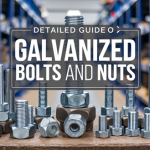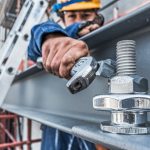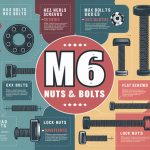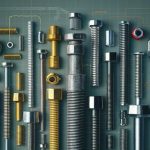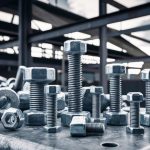Introduction
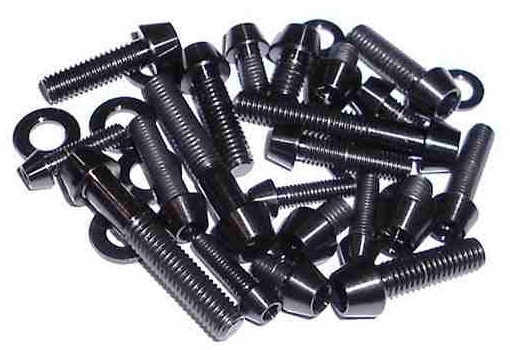
The world of fasteners is experiencing a revolution! High tensile fasteners are taking center stage, and for good reason. These ground-breaking miracles are not only altering the way we shape and create, nonetheless, they are working keeping sustainability in mind.
In the case of making stronger, lighter, and more efficient structures. High tensile fasteners have arisen as a game-changer and are supplied by high tensile fasteners suppliers. Made from eccentric materials like steel, bronze, and titanium, such fasteners claim tensile strengths. This means they can survive larger loads, pressures, and vibrations, making them best for demanding applications in a lot of industries.
What are High-Tensile Fasteners?
The high-tensile designation normally refers to fasteners with a tensile strength scoring of at least 800 megapascals (MPa), nonetheless, they can go even larger depending on the particular requirements. High Tensile Fasteners Innovation are engineered to withstand significant levels of tension, creating them perfect choice where strength and reliability are top. They are made from materials like alloy steel and are heat-treated to improve their mechanical possessions, such as tensile strength, hardness, and fatigue resistance.
Emerging Innovations and Trends in Fastener Technology:
1. 3D printing of fasteners
The appearance of 3D printing technology has unlocked up new possibilities in fastener design and manufacturing. 3D printing lets for the manufacture of difficult and customized parts that are problematic or impossible to create making use of old-style manufacturing approaches.
2. Nanotechnology
Nanotechnology is additional developing trend in fastener technology, giving the possibility for a stouter and less weight fasteners. It comprises the managing of materials on a nanoscale level, usually at sizes of lesser than 100 nanometers.
3. Sensors and monitoring systems
Another new development in fastener technology is the use of smart fasteners, which include sensors and monitoring systems. It enhances performance and dependability.
The structural health monitoring systems of huge mechanical systems, like wind turbines and airplanes, are possible to use for smart fasteners. Engineers may monitor the condition of the structure in real-time and identify any indications of wear and tear or harm before they cause a catastrophic failure by injecting devices into fasteners.
4. Biodegradable and eco-friendly fasteners
Decomposable and eco-friendly alternatives fasteners are a developing trend in fastener technology that offers the potential to less waste and improve sustainability. Their forward-thinking approach serves as a model for how businesses can incorporate environmental responsibility setting a new benchmark for the industry as a whole.
5. Artificial Intelligence in Design and Production
AI can identify potential weaknesses in traditional designs and propose innovative solutions that enhance performance and reliability. It can analyze vast amounts of data to identify patterns and trends that human designers may overlook.
Applications of advanced high tensile fasteners
1. Construction
High-tensile fasteners are used in the construction of buildings, bridges, and additional infrastructure projects. They give stronger connections for mechanical features like iron rods beams and pillars.
2. Automotive
High-tensile fasteners are used in the motorized industry to keep the components of a vehicle together. These devices contain the engine, the chassis, and the suspension machinery. In addition to safeguarding the vehicle’s safety, they even maintain its longevity.
3. Aerospace
They are very important in aerospace applications, where the reliability of connections is the top reason. They are used to connect aircraft, rockets, and spacecraft, where the fasteners is necessary to survive extreme conditions.
4. Manufacturing
When putting together large machinery and equipment, manufacturers uses fasteners that have a higher tensile strength. They provide the essential strength and dependability to guarantee the secure functioning of industrial gear throughout the manufacturing procedure.
Read Also: DIY Unbelievable: Unleash Your Inner U-Bolt Architect!
5. Marine
In the marine industry, high-tensile fasteners are used to safeguard many components on ships and offshore buildings. They must survive the corrosive effects of seawater and risky environmental circumstances.
6. Oil and Gas
High-tensile fasteners are used in the oil and gas sector for making pipelines, rigs, and other infrastructure. They should bear high-pressure environments and battle corrosion.
7. Railway
High tensile fasteners like screw spikes and rail spikes are used to hold the tracks in place. Even the shear connector studs and HSFG fasteners are used in the construction of rail over bridges.
8. Mining
High tensile fasteners hold together the various components in earthmovers, such as the bucket and arm assemblies. It safeguards huge stresses involved in lifting and moving heavy loads.
Conclusion
The future of high tensile fasteners is full of possibilities; promising strength, economy and interconnected intelligence as we embrace the exciting potential of tomorrow, remember the significance of ethical considerations when thinking of future fasteners and products. The above High Tensile Fasteners Innovation is rising and creating huge differences in several areas enabling the creation of new technologies and products in various fields.
FAQs:
1. What’s the Difference between High Tensile Fasteners and Consistent Ones?
High tensile fasteners experience superior manufacturing measures that make them significantly stronger than standard fasteners. They will support much heavier loads without breaking or bending like supporting bridges compared to standard fasteners.
2. Where else can I find them besides construction sites?
From airplanes in flight, ships navigating waters far away and even medical equipment inside hospitals; to furniture, electronics or your favorite playground equipment! Keep an eye out – you might spot one right around you!
3. Can I use these fasteners in my DIY projects?
Yes, Smaller versions of high tensile fasteners can make great additions to creative tasks. Build robots with ultra-strong joints, create furniture that stands up under experiments run amok, or build miniature bridges. Just remember the right size and type for each particular job!
4. Are they safe for me to use?
Young inventors need to wear appropriate safety equipment when working with tools. Consult an adult for guidance if any doubt arises, because even our youngest heroes deserve our utmost consideration and respectful treatment.
5. What makes them So Strong?
Visualize their internal structure as an unbreakably tight team of atoms holding hands tightly. Against one another – all refusing to break free and let go! Specialized heat treatments and manufacturing techniques enhance these tiny atoms’ strength to withstand pulling forces that would break ordinary fasteners apart.
6. Do different kinds of batteries exist?
Different materials, shapes, and sizes exist for specific tasks. Stainless steel is better at resisting corrosion in salty environments while titanium aircraft batteries offer increase lightweight capabilities. And special coatings can even help heal minor cracks! Batteries act like characters who wear different costumes when embarking on different journeys!
Read Also:
> Built to Withstand the Storm: Why High Tensile Fasteners are the Unsung Heroes of Construction
> From Tiny Screws to Big Bolts: Unlocking the Secrets of High Tensile Fasteners

